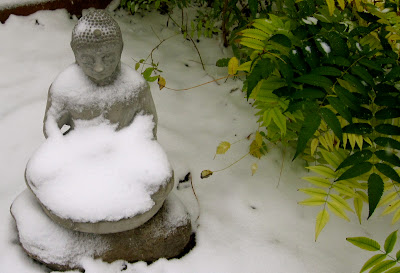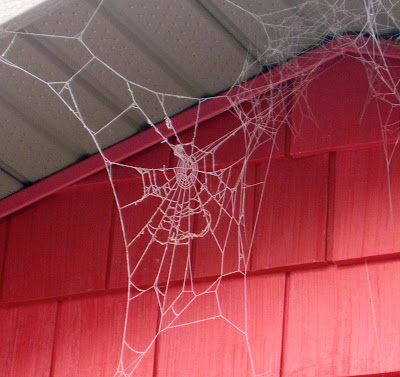 |
ART THERAPY REFLECTIONS
Friday, November 5, 2010
Thursday, November 4, 2010
Therapeutic Thursday: Talking about Stress
We all talk about stress, but what is it really? I remember when my daughter was five years old and so excited about having her own art show, then, when the day arrived her joy turned into a bad stomachache. That was stress. It was an outside show and she relieved her aching stomach by lying on the grass most of the day. Unfortunately, we can’t do that at work. If we could react to what our bodies tell us what they want at times of stress, our stress would not build up. Stress comes from both the good and the bad things that happen to us. If we did not feel any stress, we would not be alive! Stress becomes a problem when we are not sure how to handle an event or a situation and we don’t have a way to relieve that worry or stress. Like my daughter, it could start with a stomachache or a headache. We will always have stress or worry about major events in our life: getting married, changing jobs, or getting divorced. We will always have daily hassles: traffic jams or rude people. We need to find a way to release stress. When you find an event stressful, your body undergoes a series of changes, called the stress response.
 |
| Stress Painting |
Stage 1 - Mobilizing Energy
At first, your body releases adrenaline, your heart beats faster, and you start to breathe more quickly.
Stage 2 - Consuming Energy Stores
If, for some reason, you do not escape from the first stage, your body begins to release stored sugars and fats from its resources. At this stage, you will feel driven, pressured and tired. You may drink more coffee, smoke more, and drink more alcohol than is good for you. You may also experience anxiety, memory loss, catch colds or get the flu more often than normal.
Stage 3 - Draining Energy Stores
If you do not resolve your stress problems, the body's need for energy will become greater than its ability to produce it, and you will become chronically stressed. At this stage, you may experience insomnia, errors in judgement, personality changes and maybe a serious illness, such as ulcers.
 |
| Stress Painting |
Coping with Stress
We store and need to release stress mentally (i.e. worry), physically (i.e. constriction, pain), and emotionally (i.e. feeling sad, depressed). My daughter lay on the grass, which helps stretch out a tight stomach, and gave her a sense of grounding or safety. Physical activity can be a great stress reducer. Go for a walk, take up a sport, dig in the garden, or do simple stretching. Stretching relaxes the parts of the body that hold stress. You may find it helpful to learn some relaxation exercises, deep breathing and meditation. For emotional release connecting with another to talk and share your story is an effective cure. When my daughter’s friends showed up and started laughing and talking with her, she let go her fear and belief that having an art show was scary. If you make a habit of taking pressure off yourself by getting rid of your tension (emotional, physical, and mental), you will find yourself less stressed and more able to solve the problems that caused your stress in the first place. Creating art after a busy day working at an office, teaching or whatever you do is a great stress releaser. It gets your body physically moving; helps you get in touch with your emotions and helps you empty your mind of the day’s clutter. Here is a distressing art therapy exercise:
Take a large piece of paper. Have lots of paint. Start by doing some deep breathing and centering. Standing and moving the whole body, make large arm movements and paint large circles. Work big until your body feels relaxed and stretched, then start coming in smaller by making smaller shapes while saying out loud or to yourself things you want to release about the day. Keep working smaller until you reach the size you want to continue working at. Then paint one thing that you enjoyed about the day. This painting usually is abstract with lots of colors and feelings. It is a good stress releaser, try it.
 |
| Stress Painting |
References for Stress:
Books on stress:
Art Therapy and Stress:
Good blogs slowing down, relaxing, reflecting:
Monday, November 1, 2010
My New Art Work: Archetypal Theatres
I have been working on creating Archetypal Theatres. These theatres contain the symbols, objects, words and feelings of each archetype. They are about 2 feet by 3 feet.
What I wanted to capture here was the adventurous, spontaneous and playful nature of the Fool. I created a gypsy caravan for the Fool's home.
In this art piece I wanted to show the magical, passionate, and creative fire nature of the Magician. I used an old carrying case that I imagined a Magician could carry to stage shows.
In this piece I wanted to portray the layers of mystery, poetic intrigue and emotional depth of the High Priestess. What do you think? Share your thoughts.
 |
| Fool Archetype |
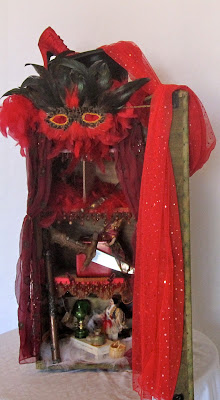 | ||||
| Magician Archetype |
 |
| High Priestess |
Friday, October 29, 2010
Monday, October 25, 2010
Refllecting on Archetypes: High Priestess
I have had all my life a series of strange, indefinable, instinctive feelings and visitations that bypass logic and make no sense. Call it intuition... I think of these moments as something instinctive at work.
- Ralph Shapey
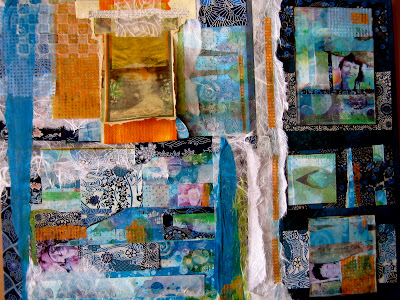 |
| High Priestess Collage |
The High Priestess is the part of you that is the mystic, poet, healer and dreamer. She was Oracle of Delphi, the muse for Shakespeare, the protector of the Temple of Solemn and the mystical seer in many royal courts. She was Isis, Diana, Artemis, or Morgan Le Fay. She represents your inner knowing, silence and emotions. She lives in your unconscious realm. The High Priestess understands metaphors, symbols and images and speaks to you through memories, feelings, introspection and dreams. She takes you to your emotional depths to find the wisdom buried there.
She works by helping you develop your inner knowing or intuition.
… a dreadful mistake occurred when our culture took the view that spirit is to be attained by the suppression of nature and instinct. Spirit can attain its divine heights only with the power of nature to provide the strength for its fulfillment. One can proceed with one’s spiritual journey only with the understanding that opposites are constantly close to each other. It is never a matter of one vanquishing the other but a matter of each performing its proper function. - R. A. Johnson
“I shut my eyes in order to see.”
- Paul Gauguin
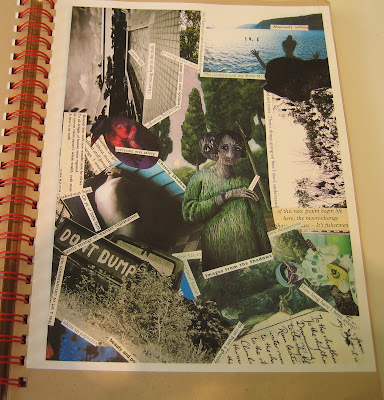 |
| High Priestess journal entry |
Creating a High Priestess Collage
When making a collage for your High Priestess pick images that reflect your silence, your quiet, your inner urges and your deep inner knowing. What things in your universe reflect this archetype? How much do you let her play in your life? Is she visible, honored, listened to or ignored? What images can you put in your collage that talk about your history, your past or your memories? Is there a story or myth that comes to mind when you think of your expression of this archetype? Fairy tales are good reminders of themes that we have played out in past lives. Is there a fairy tale that sounds like it reflects the soul work you are doing? Is the High Priestess evident in your life on a surface level or is she buried deep in your psyche? You could try to do this collage after experiencing a dream or deep meditative state. You could use colours that remind you of darkness, images that reflect shadows, and words that talk about what is under your surface existence. Make it become a window that you can see through into your intuitive nature.
Subscribe to:
Posts (Atom)
Art Therapy, Somatic Therapy Websites
Blog Archive
-
▼
2010
(43)
-
►
September
(9)
- Podcast with Ricë Freeman-Zachery talking about Cr...
- The Creative Process and Getting Derailed
- The Art of Uncluttering Your Inner and Outer Life
- Reflecting onTherapy Groups: Valley Ridge Art Stud...
- Resourced, Resilient, and Reattached
- Reflecting on Art Therapy Exercises and Sandtray
- Reflecting on Depression
- Reflecting on working with addictions
- Reflecting on Making Mistakes
-
►
September
(9)
About Me

- Karen Wallace
- Karen Wallace BCATR is an art therapist, artist, and art instructor living and working in Regina SK. Canada. She has a private practice with adults and children and specializes in depression, trauma, life transition and abuse work. She facilitates art therapy, creativity and art groups. She teaches internationally. She shows her mixed media art in galleries in Regina, Victoria B.C. and the Gulf Islands. Karen is known for her enthusiastic and dynamic teaching style. Her workshops are rich, playful and creative. Karen’s art work is a reflection of her art therapy work. She expresses her love of nature, her practice of Buddhism and her family in her art. Web site: www.islandnet.com/~kwallace
